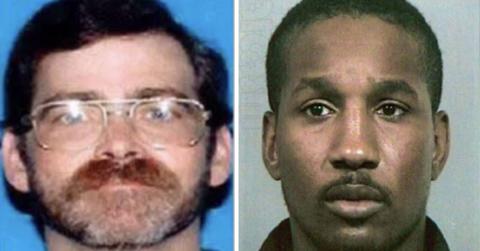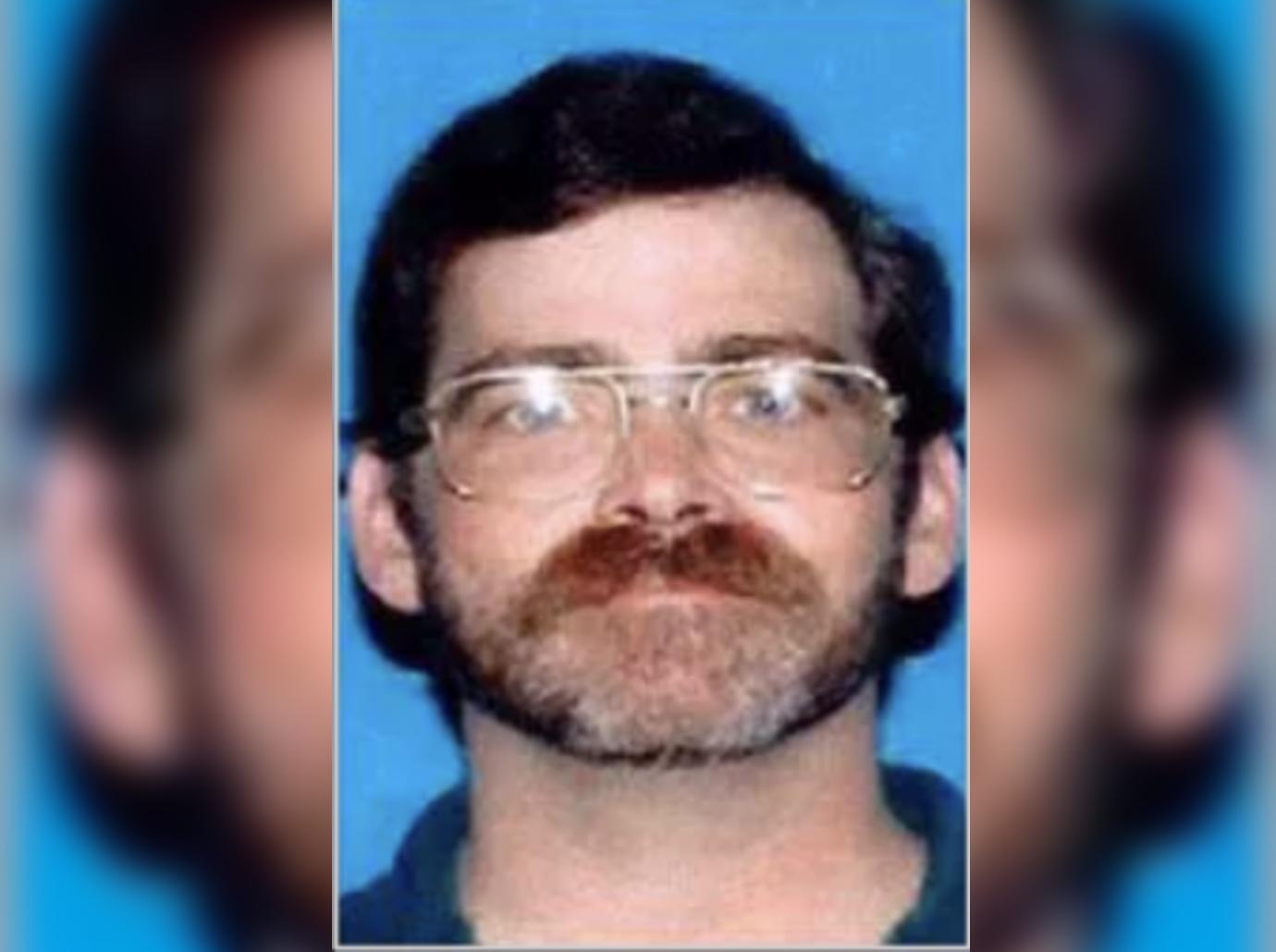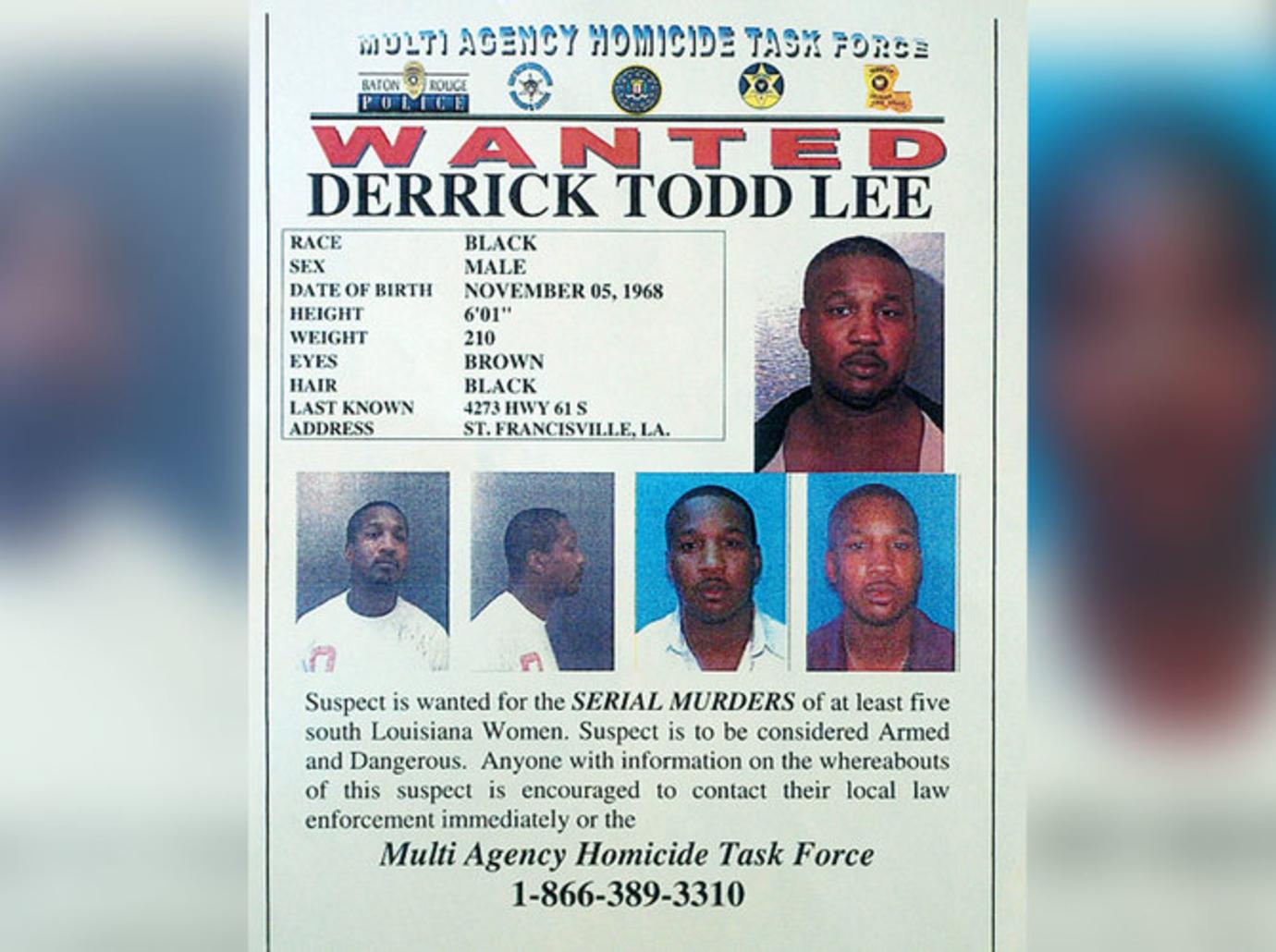Two Serial Killers Hunted for Victims in Louisiana. They Worked Separately But Terrorized Together.

The first victim was an 82-year-old woman named Ann who lived in an assisted living facility. She was attacked in her upscale, secure apartment. When Sean Gillis touched her, she screamed. Intending to rape her, he admitted to not knowing what to do, so he stabbed her 47 times, nearly decapitating her.
Ann Bryan was an artist and musician with many friends in her small Louisiana retirement community, across the street from Gillis’s job. She’d left her front door slightly ajar out of habit. That made it easier for the nurses to get inside.
Between 1991 to 2001, the years in which Gillis and fellow serial killer named Derrick Lee mostly operated, there were 878 homicides in East Baton Rouge Parish, Louisiana. For over three decades years, the state of Louisiana had the highest murder rate in the US, according to the New York Times.

Gillis and Lee worked separately but terrorized the community for the better part of a decade. The investigation into one led to the arrests of both.
Together, they were responsible for more than a dozen deaths in the community.
QUIETER THAN AVERAGE
Gillis lived with his mother until he was 30 years old and later admitted to wishing he could have sex with her.
He’d always been quiet, getting C's in high school and trying out community college without graduating. By the time he slipped into a private world of porn and violent fantasies, he was too far gone and miles away from his mom, who’d moved to Atlanta to pursue a job.
She sent money, and he lived in the same house where he grew up, but he often raged at her on the telephone for leaving him.
The neighbors left him alone.
Gillis grew up in Baton Rouge without much direction about how to make his way in the wider world. His father abandoned him in early childhood after the man struggled with alcohol addiction and mental illness. Gillis seemed to adjust, developing a close relationship with his father in his teens for about a year until he discovered his father was gay.
He was first arrested in 1980, at 18 years old, for criminal trespass. As the years went on, he got into minor scrapes for drug possession, traffic charges, and contempt of court, according to murderpedia.org.
In 1992, Gills was arrested for criminal trespassing again. His crime was one that often marks the starting point for a later career in home invasion, rape and murder — he was loosely classified by the Baton Rouge police as a peeping Tom.

Two years later, the fantasy world of online porn finally expressed itself in a horrible crime when Gillis acted out a desire to rape. He had a clear view of a retirement complex across the street from the convenience store where he worked, and his mind sorted through scenarios about how to break in.
One day in 1994, early in the morning, he slipped inside the open door of Bryan’s unit.
SIGNS WERE THERE
In Zachary, Louisiana, about a half-hour north of Baton Rouge, another peeping Tom was arrested. His description would later match evidence authorities collected about a serial killer stalking their city.
The perp was 34-year-old Derrick Todd Lee. Police got his DNA as they canvassed neighborhoods, taking swabs from men who could fit the profile.
Lee had a history of spying into bedroom windows; his first arrest at 17 years old got him a slap on the wrist. As a teen, he was charged with attempted second-degree murder but managed to stay out of jail.
Lee’s school records showed an IQ below 70, and he’d been known to torture animals as a kid. As an adult, he married and had two children but lived a double life. His wife knew he cheated on her and spent his off-work hours in bars, but she tolerated it, according to thoughtco.com.
Collette Walker lived near the Lee household, and in 1999 filed stalking charges against her 30-year-old neighbor, who tried to push his way into her living room. The charges didn’t stick, and she moved away. Lee was put on probation, and within the next year his life began to unravel.
His wife, Cassandra, sought a protective order against her husband after she’d had enough of the violence at home. When he assaulted her in a parking lot, his probation was revoked.
On April 2, 1993, Lee was arrested when he attacked two teens who were making out in a parked car. He swung a harvesting scythe at them, but another car drove up, interrupting the attack. By the time the female identified Lee in a lineup, six years had passed and the statute of limitations ran out to convict him.
BRUTALITY ALL OVER TOWN
Despite an inaccurate FBI profile of the killer, and an eyewitness who swore he saw a white man, the police eventually tied Lee to a string of murders. They used crime-scene DNA from the victims, but they couldn’t make headway until they cleared up a problem with race.
Because of the FBI profile and eyewitness account, authorities focused on finding a Caucasian killer. After testing thousands of white men, the trail went cold and they went back to the drawing board, examining the DNA evidence more closely. A more in-depth genetic profile revealed the serial killer was 85% Black and the rest of his background was Native American.
They quickly began testing likely suspects who were Black and found a positive match in Lee. DNA dug from under the fingernails of one victim specifically identified Lee as the killer. Tests discovered five more murder victims linked by DNA.
On May 27, 2003, law enforcement captured Lee in Atlanta, extradited him, and charged him with second-degree murder in the death of Geralyn DeSoto, a 21-year-old graduate student at Louisiana State University. He’d broken into her home one January afternoon. She was his second victim.
ONE SERIAL KILLER IDENTIFIED
Known as the “Baton Rouge Serial Killer,” Lee would be convicted for first-degree murder and receive the death penalty for killing 22-year-old Charlotte Murray Pace on May 31, 2002.
Like the rest of Lee’s victims, Pace was chosen at random. Pace, who went by her middle name, Murray, had just received her master’s degree in accounting at LSU and was getting ready to start a new job in Atlanta.
Lee watched and stalked Pace, who let him in her apartment after he came to the door pretending to look for work. He attacked her with a screwdriver and beat her to death with an iron. He cut her ears in half and stabbed her 83 times.
She fought her killer with everything she had. After he raped her, he slit her throat, according to the Clarion Ledger. It was in her fight to survive that Pace sunk her fingernails into her attacker, where his DNA lodged.
Lee was the killer Baton Rouge police wanted to find, but they scooped up more serial killers in their investigation to find Lee. Lee’s victims were professional women, while Gillis murdered women from the streets, usually sex workers who tended to get less media attention and have fewer family members able to fight for their memories and their rights.
In 2002, the Baton Rouge Police Department formed a task force that initially focused on solving the crimes of Derrick Lee, because his victims were professionals and the attacks got more airplay. The parents and siblings of Pace and others put more pressure on law enforcement by keeping the lives of their loved ones in the press.
In North Baton Rouge, many of the street workers faded out of sight in a deafening silence while Gillis killed and mutilated. But, their families pushed police to find the killer. While they were investigating Lee, they were able to tie separate, but similar, killings to Gillis.
- AS BODIES PILED UP ON LONG ISLAND BEACHES, POLICE BELIEVED IT WAS A SERIAL KILLER'S WORK. A LOOK AT THE GILGO BEACH MURDERS.
- Killers Among Us: 4 Suspected Murderers Who Wore Mask of God-Fearing Family Man and All-Around Nice Guy
- Paradise Lost: How a Serial Killer Known as the 'Honolulu Strangler' Terrorized Hawaii (FPD CASE VAULT)

Gillis became known as “The Other Baton Rouge Serial Killer,” and his acts were of a depraved, violent psychopath who raped most of his victims.
For Gillis, the violence escalated after his victim’s death to mutilation and dismemberment of their bodies. Lee and Gillis prowled Baton Rouge for a decade, from 1994 to 2004.
GILLIS’ ACTIVE YEARS
Gillis couldn’t suppress his narcissism and spent hours telling the FBI all about himself after he was arrested in 2004.
Although he’d lawyered up, making his sorry-not-sorry confession inadmissible in court, the narrative of his other confessions was eventually allowed by Judge Robyn Free at his June 2006 trial because he’d also given a lengthy interview to a journalist and written confession letters to a friend of one of his victims.
Gillis recounted he was content between 1994 and 2003 and didn’t feel the need to kill, according to murderpedia.org.
He targeted a 30-year-old woman named Katherine Hall, who sometimes did sex work to make ends meet. She lived in a housing project on North Street and climbed willingly into Gillis’s car. Her body was found in January 1999 by a hunter — she had been raped and stabbed. Her throat was slashed.
Gillis began cruising for victims and looking for the next opportunity. He found it in May 1999, attracted to a 52-year-old jogger Hardee Schmidt.
Schmidt was taking an early morning run. Gillis stalked Schmidt for three weeks and found her out jogging again early on the morning of May 30, ramming her with his vehicle. He subdued her with a cable around her throat, stuffed her into his car’s trunk and drove to a park where he raped and murdered her.
This time, Gillis’s left the body in his car overnight before driving out of town. Schmidt’s body was found the next day by a bicyclist. She was a mother of three children. She was found floating in a bayou on the road to New Orleans, her body mutilated.
Over the next year-and-a-half, Gillis targeted three more victims and go entirely undetected by authorities.
On Jan. 22, 2000, the remains of Joyce Williams were discovered behind a levee. Her killer picked her up on Nov. 12, 1999. Gillis later confessed that he’d killed Williams with a zip tie that night, took her back to his house and dismembered her. In this instance, Gillis first tried cannibalism. He packed her body parts into plastic trash bags and a Xerox box, according to journalist Susan Mustafa, and drove to neighboring Parish to dump them.
He later picked up Lilian Robinson, 52, in North Baton Rouge and strangled her with a zip tie. A devoted churchgoer, she was murdered in January, but her body wasn’t found until March. He dumped her in a swampy area after taking her body home with him.
In late October 2000, Gillis picked up Marilyn Nevils and attempted to put a zip tie around her neck. She fought and got away, running across a field. Gillis chased her town and knocked her unconscious with a piece of rebar, according to Mustafa, and killed her as he’d planned — with a zip tie around her throat. After taking a shower with her body, he drove her to a levee near the Mississippi River and left her there.
By the time she was found on Halloween, her body had begun to decompose.
Gillis was back in North Baton Route on Oct. 9, 2003, where he picked up his friend Johnnie Mae Williams, a mother of three. He beat her to death, then cut off her hands. He left her body in the woods and took photos of her in various positions for souvenirs.

The last victim — and one who would send Gillis to jail — was Donna Bennett Johnston. She was a mother of five who lived in North Baton Rouge. In early 2004, Gillis picked her up and tried to put a zip tie around her neck. When she got into his car, she was intoxicated and in no state to fend off an attack.
He drove Johnston to an out-of-the-way spot. Although she tried to run, he caught her. After he’d strangled her to death, he threw her body in his car trunk and took 45 photos, according to Mustafa, before dismembering her and cannibalizing her remains.
GILLIS CAUGHT
Johnston’s body had tire tracks next to it, and they were an unusual brand. They led police to a white Chevy Cavalier owned by Gillis. His house was a few blocks from the ravine where Johnston’s ravaged body was found. On April 28, 2004, police went to Gillis’s home and took a DNA swab.
The Baton Rouge police called in the SWAT team the next day. They showed up on the doorstep of the home his mom left for him on Burgin Avenue, a little after lunchtime.
Detectives detained the cooperative suspect and arrested Gillis after combing his home. They found knives, a hacksaw, a bayonet, a machete and an assortment of plastic zip ties, along with photographs of Williams. They recovered snuff films from his hard drive and books about serial killers on his bookshelves, according to murderpedia.org.
He confessed the same day he was arrested.
Gillis was transported to East Baton Rouge Parish Prison on April 29, 2004, and charged with three counts of first-degree murder and ritualistic acts relating to mutilation.
He was convicted of killing Williams, Nevils, and Johnston but eventually admitted to murdering eight women. Prosecutors got the first-degree charge they wanted and although the jury couldn’t agree on the death penalty, the trial put Gillis away for life without parole.
A SAFER BATON ROUGE?
Lee died before he could be executed, shortly after being moved off death row at Angola State Prison to a nearby hospital. He was 47 years old and died from heart disease. A coherent account of his motives has never come to light, aside from the obvious — he liked to stalk women.
Many believe he was caught because the investigative task force finally got the right set of leads, a good sketch, provided by the only victim to survive one of his assaults —along with law enforcement sweeping the parishes where unsolved murders were rampant by asking for DNA from males who fit the profile.
Gillis got caught in the net meant for Lee, but eluded police for just as long, perhaps because he, too, chose his victims randomly based on opportunity. He only had a connection to one of the women he brutally murdered.
Gillis and Lee were snared when technology and old-fashioned detective work caught up with them, but bodies piled up in the ensuing years.
In the years since both Baton Rouge serial killers went to prison, DNA methods and analysis have taken law enforcement into new territory. In Baton Rouge, the murder rate is still multiple times higher than the average American city.
But, the two killers are no longer responsible.
Become a Front Page Detective
Sign up to receive breaking
Front Page Detectives
news and exclusive investigations.
